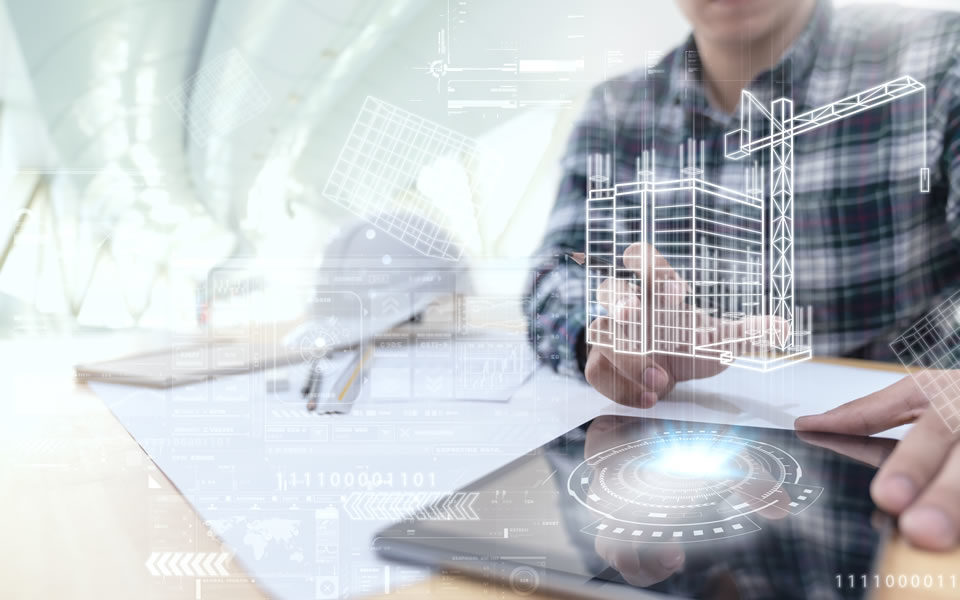Digital Technology Transformation for the Construction Industry
By Nick Ward, Supervisor, Assurance Services
Digital technology has markedly changed the way of doing business, with the goal of realizing efficiencies and meeting customer expectations. The manufacturing and retail industries were early adopters, and now other industries – including construction – are finding ways to engage digital tools to better track projects, save costs, and train workers. While many contractors traditionally have been reluctant to embrace digitalization, the need to improve productivity is driving the need for change.
For an industry already grappling with a labor shortage, the COVID-19 pandemic has added yet another challenge for contractors trying to meet project deadlines. Many construction firms are working with a staggered workforce to help contain the virus. The effective use of digital technology can help optimize shared data to help keep projects on track. The good news is that many digital tools are affordable. The key is to maximize the value of the digital tools you already have and plan now for adding technology that will successfully carry your business into the next decade.
Digital Transformation in Construction
Construction is a collaborative industry. There is a need to monitor progress, provide team updates, and troubleshoot challenges. Before smartphones, contractors and project managers spent the majority of their time traveling to each job site to oversee job progress. The introduction of cloud-based apps, which made it possible for workers to leverage technology from anywhere, is now widely used to schedule and track projects. Today, through cloud-based technology, jobsite workers can rely on their mobile devices for real-time communications, whether it is to communicate updates from the field, automate tasks or track financial data, and that allows managers to stay in the office while remaining connected to their teams.
Cost Containment
COVID-19 and the accompanying recession have caused every business owner to scrutinize cost outlays and prioritize overhead expenditures. Changes in the world economy have forced contractors, who are carefully monitoring material costs, to consider supplier diversification to avoid project delays should there be another pandemic-induced shutdown. Contractors can use data analytics to help analyze material costs, general expenses, and timelines to help contractors make smart decisions. In fact, software and hardware costs have dropped, making it easier for contractors to smartly use digital tools to help plan for short- and long-tern costs.
IoT
Most construction firms are already using the Internet of Things (IoT) in some capacity. IoT simply refers to the cloud-based connectivity of web-connected devices to exchange data. In construction, the IoT allows materials, equipment and machinery to communicate with one central data platform, allowing information to flow freely among construction crews and project managers. For example, IoT can be used to predict and prevent jobsite bottlenecks, stretch resources and improve accuracy and efficiency. It also can be used to help project managers understand how much of their equipment is being utilized and make necessary adjustments.
Marketing
Many contractors have experienced a healthy backlog over the past several years. In times of uncertainty, it will be essential to line up next projects and secure financing. Analytics can help position your business with potential developers and builders. For example, you can use search engine optimization (SEO) tools to ensure that your construction business is ranking for searches in your area. There are a host of digital marketing tools you can implement at a relatively low cost, including Google AdWords and account-based marketing (ABM) to target specific prospects.
Looking Ahead: Augmented Reality, Drones, Robotics, and 3D Printing
While some construction firms may be experimenting with augmented reality (AR), the cost for these tools is higher than those already mentioned. AR takes a computer-generated image and superimposes it on the user’s view of things. For example, if you are learning about a new piece of equipment, AR systems can communicate critical information about the equipment, including safety precautions and how the various parts of the equipment work together. AR can even send alerts to let the user know there are dangers nearby. From the customer perspective, you can overlay a visual of the completed project before the work has even begun. For cash-strapped companies, AR may not make sense right now, but expect it to become more widely adopted when the economy improves.
Drones are already being used for tasks that are dangerous to workers. They are able to survey locations that are difficult for workers to view, and allow project managers to supervise projects in real time. Robotics are still evolving, becoming more precise, and 3D printing offers the ability to look at small scales of designs that can be cost-effectively modified before full-scale construction begins. Building information modeling (BIM), a smart 3D model-based process, enables construction workers to more efficiently plan and construct building. These technologies combine to offer the construction industry the ability to improve communication, have safer jobsites and avoid costly delays.
Thinking digitally can help construction companies become more agile in meeting customer expectations and changing business models to integrate the technology to their greatest advantage. Construction firms that have embraced digital technologies will also have an advantage when recruiting new talent entering the workforce.
The professionals in Marcum’s Construction Services Group are dedicated to helping contractors build a more profitable and valuable construction enterprise. Contact your Marcum professional for assistance.



















